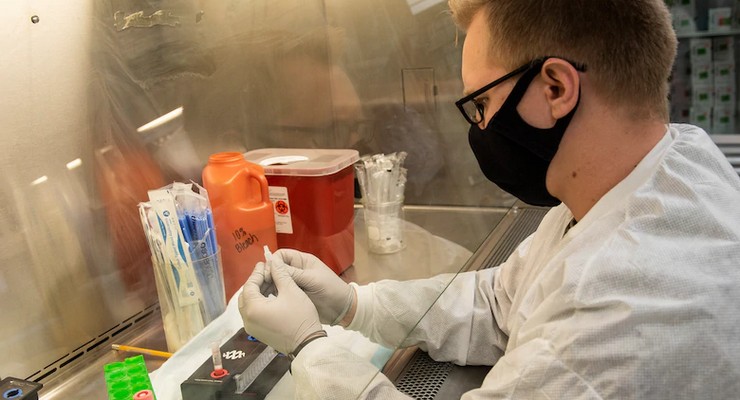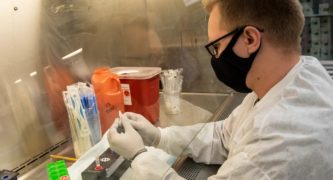
Pandemic precautions and the increased reliance on technology that has accompanied them have reshaped countless aspects of daily life, from education to grocery shopping. But even after the virus is gone, local experts say some of the changes seen over the past seven months are likely to remain as permanent fixtures of the so-called “new normal.”
Online meetings have quickly transformed from quirky alternatives to traditional events and mainstays of business and educational operations. E-commerce has exploded, while many brick-and-mortar businesses have struggled to survive. And the medical field has increasingly espoused remote options for patient care.
While the natural craving for face-to-face interaction will restore a great deal of daily social interaction once the viral threat has passed, experts, among them ArtCenter College of Design Professor of Interaction Design Todd Masilko say some of the changes brought about by the pandemic — particularly with respect to the increased use of technology — are now likely permanent fixtures of society.
“There are actually quite a few things that I think will stick,” Masilko said.
For example, ArtCenter teaching staff has become proficient in creating recorded lectures for online distribution, according to Masilko.
“As soon as we can get back on campus and students can get into the shop or into a studio room with their classmates, we’re definitely going to want to do that,” he said.
But at the same time, “Being better at that as an instructor and being more comfortable using pre-recorded content, for example, that can then save time in the studio for the things that studio time is best used for.”
“And I think we’ve gotten a lot better at it, as instructors. We’ve gotten better at lighting and microphones and being comfortable on camera and getting used to recording things and posting that on the software that the school uses to manage its classes,” Masilko added.
Online material also allows for information to be disseminated on a virtually unlimited scale, rather than being confined to those within earshot of the professors, he said.
The new reliance on online meeting and document-sharing platforms has also highlighted the need for continued development in the field, Masilko said.
“It’s really clear that almost all of this stuff was designed and developed with relatively short engagement in mind — a quick meeting or a few people collaborating on a document,” he said. “Having large groups of people using the software tools daily, for hours on end, you really see where we need to up the game, if you will, from both a design and usability design standpoint, but also just the way that it’s engineered and developed.”
“There’s that term ‘Zoom fatigue,’” he said. “It’s not the same. No matter how good your broadband connection is, and no matter how good your webcam is, it is not a replacement for being in the room, being able to hear more than one person speaking, being able to look in their eyes and get a sense of whether or not they’re confused about something. A lot of that stuff is not so perceptible through the digital platforms and it really does wear people out.”
Pasadena City Councilmember Andy Wilson, who serves as executive director for The Alliance for Southern California Innovation, a nonprofit dedicated to helping implement innovations and technology in Southern California, also said some of society’s pandemic protocols are almost certainly here to stay.
“I would say our behaviors have started to solidify in ways where technology is being used more ways,” Wilson said. “But you could also overdo it on these things. Ask anyone about how much time they spend on a Zoom meeting. They’re very much looking forward to replacing some of that with some in-person interactions.
“We’ll probably see some pullback in some areas as soon as people are able to do so, but many of these practices will become, at least to a reasonable extent, ongoing,” Wilson said.
On the positive side, a more widespread use and acceptance of telemedicine “is going to be transformational,” he said.
“And obviously, we have a real leader in that field here in Pasadena, with Kaiser having their headquarters here and the medical school being here,” according to Wilson. “Telemedicine, I think, is absolutely a good thing.”
E-commerce habits picked up during the pandemic may also become permanent for many, he added.
“It depends on what category you’re talking about,” Wilson said.
Although he hadn’t used online grocery shopping much prior to the pandemic, from a personal perspective, “I think I will continue to probably maintain some level of online grocery shopping, just because it’s convenient. But as a cook in my house, I still like to select the fish, select the meat and the vegetables. But general staples, you can get delivery pretty easily.”
The Alliance for Southern California Innovation has recently discussed the potentially permanent changes brought on by COVID-19.
“We hosted a conference with 12 CEOs out of San Diego talking about how the workplace and work culture are going to change as a result of the pandemic,” Wilson said. “We literally had that conversation last week.”
Caltech Professor of Business Economic Jean-Laurent Rosenthal said the pandemic’s reshaping of communication in the modern business world will have lasting effects.
“The most important and permanent change that is coming out of technology through the COVID shutdown… has to do with a variety of issues in communications,” he said. “The most obvious one, the one that’s going to happen most directly for Pasadena and the L.A. area, is telecommuting.
“One thing that we’ve experienced is that you don’t actually have to go in every day to be productive,” Rosenthal said.
It may end up reshaping not only business interactions, but the layouts of cities and communities, he said.
“If you’re going to be working in Pasadena and living an hour-and-a-half away and only coming in one day a week, that’s a feasible thing. It becomes much more costly to commute an hour and a half every day to come into Pasadena,” Rosenthal said. “And so you can imagine that city centers, which have been very attractive in the last decade, now become a perfectly fine option, but the suburbs become a better option relative to what they were before holding traffic conditions the same.”
Business travel will likely never resume pre-pandemic levels, as companies continue relying on electronics rather than airplanes, he added.
“That’s probably going to stick just simply because companies will want to watch their bottom line,” Rosenthal said.
Some of the potential permanent changes are “a bit more ambiguous,” according to Rosenthal.
“There will be more online retail than ever before. COVID has probably accelerated that to some extent. But there is a social aspect to shopping in Old Pasadena or at the mall. So that issue is going to be complicated because, to some extent, as we’ve seen during COVID, this is why getting control of COVID is difficult: People want face-to-face social interactions. It’s psychologically valuable to them,” he said.
“Restaurants aren’t going to disappear, but at what point will people be starting to feel safe to go back to restaurants that are densely packed?” Rosenthal asked.
While the widespread adoption of newer technologies in the business world has increased a great deal during the pandemic, many of the tools employed today are not brand new inventions.
“The really big platforms like Zoom were already in place. Cloud computing is what made that possible. That was already there. What’s happened is we scaled some activities up,” said Rosenthal.
“Amazon didn’t invent home delivery or its website for shopping [during] COVID. it was there. So a lot of what we’ve done is we’ve been pushed to use these technologies much more intensively,” he said.
Some of the sweeping changes in the workplace made in response to the pandemic out of necessity will likely not revert to those of the pre-COVID period, said Pasadena Chamber of Commerce President and CEO Paul Little.
“One thing that people are getting used to and comfortable with is the idea of flexible workplaces. People are comfortable in a lot of industries now with the work-from-home models,” Little said.
“I don’t think that necessarily financial institutions, for example, or insurance companies will go to 100 percent work-from-home models, but they may actually look at flexible schedules and have half their people work remotely half the time, and consequently, require half the space,” Little said. “That’s something we should watch and see, especially in those kinds of office-based businesses.”
Amazon’s hiring tens of thousands of people all around the country, Little said, “and they’re pressured to deliver things faster. The more that that happens, then the workforce is going to change to some degree.”
“If the only job [someone] can get is to move to the Inland Empire and get a job in a warehouse, they’re going to do that,” Wilson said. “Their wages aren’t going to go up, and they may go down, but people will go where the work is.”
Little urged Pasadenans to support their neighbors by supporting local businesses.
“The real hope is that people remember that even though it may be easier and a little less expensive to shop on Amazon, it is way more important right now to shop with the local people,” he said.
“Because if we don’t buy from them, we may be saying goodbye to them, which would be a shame for a lot of reasons, but they also employ a lot of people,” Little said.
See also:
Innovate Pasadena’s Connect Week Highlights Local Tech Community














 0 comments
0 comments


